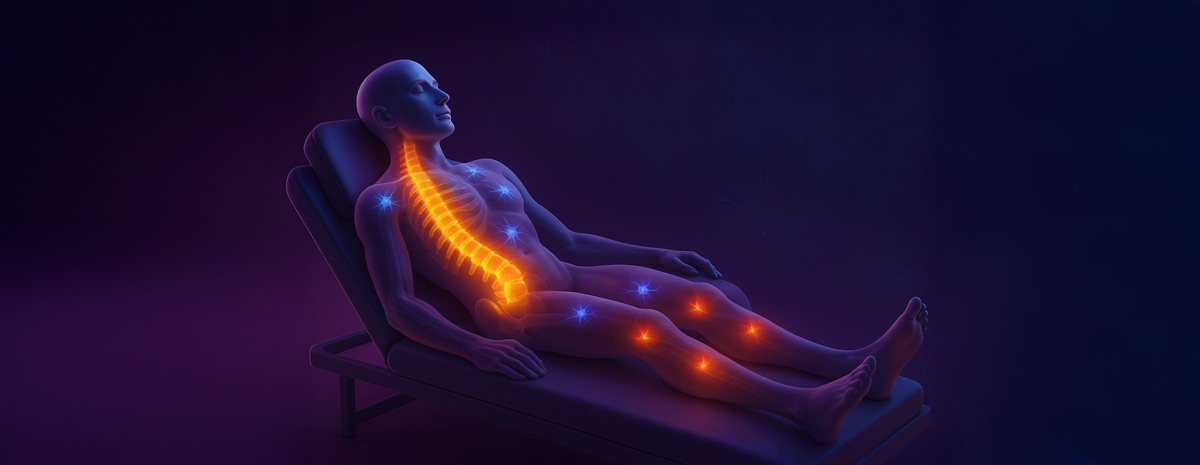How Long Does Ketamine Pain Relief Last?

Summary
Living with pain that never seems to let up can feel overwhelming. You’ve tried different treatments, yet relief fades too quickly or never really comes. Treating chronic pain usually needs various methods. These methods help the brain change how it feels pain over time.
Ketamine therapy may be beneficial to some people who have chronic pain that ketamine may impact. Some people have said their pain feels less intense over time. Others have said their thoughts about pain (metacognition) have become more balanced.
Ketamine therapy is not right for everyone. Some people have said it did not help their symptoms at all.
In this article, let's explore how long the effects of ketamine may last. We will also talk about different types of pain and why each person's experience is different. You can learn how to pair the Limitless App to support decreasing pain perception naturally, and build skills to self-regulate your nervous system, emotional resilience, and mental adaptability over time.
What Is Ketamine Therapy IV Infusion?
Ketamine therapy involves a controlled infusion of ketamine delivered through an IV drip - typically 0.5 mg per kilogram of body weight over 40-60 minutes in a clinic. This setup may help your body reset how it processes pain signals, turning down the “volume” on chronic pain. How long does ketamine pain relief last? This is where we need to understand the complexity of chronic pain and how over time it can rewire your brain to amplify the perception of pain.
Imagine your pain as an alarm blaring nonstop. A ketamine infusion works like a technician gently adjusting the alarm’s sensitivity so it only rings when it really needs to. After treatment, that quieter state can last anywhere from hours to days, giving you a window of comfort. Treatments are usually given in a series up front for several weeks to help your mind maintain a state of reduced pain perception.
Understanding Chronic Pain
Chronic pain may stick around long after an injury or illness should have healed. It doesn’t always come from ongoing damage -instead, your brain and nerves can stay on high alert even when there’s no clear reason. Unlike short-term pain, which usually ends as your body heals, chronic pain has no set “stop” date and can affect your life in new ways over time.
Approaches to managing chronic pain may include pain science education and a Biopsychosocial approach to reduce the high alert signals that the brain has become wired to repeat over and over again.
What are the types of pain?
Pain comes from how your nervous system reacts. There are four main types:
- Nociceptive Pain
- What it is: Pain from real or potential tissue damage (like a cut, burn, or arthritis)
- How it feels: Aching, throbbing, or sharp
- Examples:
- Somatic (skin, muscles, bones): a sprained ankle or sore back
- Visceral (organs): cramps from inflammatory bowel disease
- Neuropathic Pain
- What it is: Pain from nerve damage or disease
- How it feels: Burning, tingling, electric shocks
- Examples:
- Peripheral: diabetic nerve pain, shingles (post-herpetic neuralgia)
- Central: pain after spinal cord injury or stroke
- Nociplastic Pain
- What it is: Pain without clear tissue damage or nerve injury
- How it feels: Widespread aching, sensitivity, or tenderness
- Examples:
- Fibromyalgia
- Complex regional pain syndrome (CRPS) type I
- Irritable bowel syndrome
- Mixed Pain
- What it is: A combination of two or more pain types
- Why it matters: Treatment may need to address multiple pain mechanisms
- Examples:
- Failed back surgery syndrome (both nerve and tissue pain)
- Osteoarthritis with nerve irritation
Understanding your pain type or the mixed pain combo can help you and your care team choose the best strategies - like a multi-pronged approach to chronic pain management. For example a treatment plan may include many approaches: ketamine therapy, gentle movement Tai Chi, and daily practice through guided imagery - to manage discomfort effectively.
Factors Shaping Ketamine's Analgesic Effects
Every one of us is different, and our bodies and minds respond to various treatments differently. Here are some factors that
- Dose Level
- Typical infusions vary in strength. Higher or repeated doses may stretch relief but can also bring stronger sensations during the drip.
- Session Frequency
- Weekly treatments are often reported to lead to steadier, longer comfort than a single session.
- Personal Biology
- Your unique pain history and body chemistry influence how ketamine works for you.
- Co-Care Practices
- Gentle movement, Tai Chi, breathing exercises, somatic movement and guided imagery like the channels in the Limitless Guided Visualizations app may improve benefits as your brain learns to "turn down the alarm" on pain perception.
- Pain Type
- Nerve-related pain (burning, tingling) may respond differently than muscle or joint pain.
Partner with your medical team to fine-tune these factors and find what works best.
Ketamine for Different Types of Pain Relief
How long does ketamine infusion last for pain will be different for everyone. There is no guarantee of 100% pain relief for any treatment and that includes ketamine therapy, a ketamine therapy app, medical procedures, natural remedies, or any other medication. Everyone is different and their root cause of pain is different. It is important to work with a supportive medical provider who partners with you to determine what treatment care plan is right for you.
Chronic Musculoskeletal Pain
- Reported Typical Relief: 24–72 hours of eased aching in back, neck, or joints
Neuropathic Pain
- Typical Relief: 48–96 hours of reduced burning, tingling, or electric-shock sensations
Acute Pain Flare-Ups
- Typical Relief: 12–48 hours of eased sharp or post-injury pain
Pro Tip: Boost Ketamine Therapy with Guided Imagery - During your infusion, try a Journey Macrodose session on the Limitless App to encourage the mind to dial down muscle tension and relax deeply.
Next Steps: Always work with your provider to tailor dose and schedule. Try weaving in these natural techniques to help your ketamine pain relief last even longer.
Natural Pain Management Approaches to Try Alongside Ketamine Therapy
- Metacognitive Adaptability: Notice automatic thoughts (“My pain will never end”) and gently reframe them: “This relief window helps me rest and recover.”
- Gentle Movement
- Why it helps: Eases muscle stiffness and boosts circulation
- How to do it: 5–10 minutes of light stretching, Tai Chi or a short walk each day
- Tip: Stop if you feel sharp pain
- Deep Breathing
- Why it helps: Calms your nervous system and lowers tension
- Parasympathetic Breathing
- Practice box breathing (inhale 4, hold 2, exhale 4, hold 2) three times daily to keep your nervous system in a relaxed state.
- Parasympathetic Breathing
- Why it helps: Calms your nervous system and lowers tension
- Warm Heat Therapy
- Why it helps: Relaxes sore muscles and eases discomfort
- How to do it: Apply a warm pack for 15 minutes or take a warm bath
- Tip: Add Epsom salts to your bath for extra muscle relief
- Progressive Muscle Relaxation
- Why it helps: Teaches you to release built-up tension
- How to do it: Tense each muscle group for 5 seconds, then relax for 15 seconds, moving from feet to head
Try one or two of these each day and note any changes to share with your care team.
How to Prepare for Ketamine Treatment by Creating a Personalized Plan
Learn simple steps to get ready for your infusion sessions - asking your provider for your treatment plan, how to prep your home for afterward, and tips for using guided audio to enhance your comfort and results.
1. Understand your plan
Treatment Plan: Before your first infusion, ask your care team how many sessions are planned (often 6-8 over 4-6 weeks), what sensations to expect, and how to prepare. Knowing the schedule may help reduce anxiety and feel more in control.
At home support plan: Learn about additional supportive natural pain reduction methods you can use between treatments to begin to develop a practice of managing pain from many angles. This is often more effective than using a single approach.
Arrange for transportation in advance as you will not be able to drive safely after treatment.
2. Create a Comforting Space at Home Before Leaving For Treatment
Plan to rest quietly for a few hours after each infusion. Set up a cozy spot with dim lighting, a cozy blanket and headphones/speaker ready for gentle relaxation and some Chill Music after you arrive home from your infusion.
3. Use a Kind Voice for Inner Self-Talk
Remind yourself: “Ketamine is giving my pain ‘alarm’ a chance to reset.” Simple gentle inner support can help reduce anxiety around treatment.
Encourage yourself to turn off all phone notifications, texts, and outside attention grabbers so you can be present for yourself during this time.
4. Try a Journey Macrodose During Ketamine Infusions
You’ve already set aside this time for yourself. Why not make the most of it?
- Limitless is more than music. It’s a guided audio experience designed to help you feel calm, centered, and supported during your ketamine treatment. Patients who use Journey Macrodoses often describe feeling more relaxed, less anxious, and more connected to their process.
- Research shows that guided imagery, breath pacing, and relaxation tools can reduce stress and support regulation. When paired with ketamine’s neuroplastic effects, these practices may help deepen your progress and strengthen what you’re here to change.
- Download the Limitless Guided Visualizations app and choose an intention that feels meaningful today, like internal alignment, increased sense of resilience, or feeling supported. Press play and listen to the intro before the ketamine begins to take effect.
- Designed for passive listening . No need to actively do every prompt, or follow the words exactly. Let yourself relax. Let your thoughts drift. This is your time to explore, with gentle audio in the background whenever you need it.
- These immersive tracks blend gentle narration with cinematic music to help quiet the mind and deepen your sense of presence. There’s nothing to do or figure out. Just press play and let the guidance support you as the medicine takes effect.
5. Reinforce Gains by Learning Metacognitive Skills
Between treatment days, you can begin building your metacognitive skills through Mindset Microdoses. Listen to one a day, in the order on the channel. Practice the same one until you are ready to move on. This is not a race, this is about learning to coach yourself through change.
Frequently Asked Questions About How Long Ketamine Treatment Lasts for Pain
Find quick answers to common search questions about ketamine pain relief duration, analgesic effects, and how the Limitless App can support your treatment experiences
Most people notice pain easing within 5–15 minutes of starting their infusion.
Typically 24–72 hours, though some feel comfort for up to a week.
Plan to rest 1–2 hours post-infusion. Arrange someone to drive you and keep the rest of the day light.
Your provider will tailor this to you. Some plans call for 6-8 sessions over 3-4 weeks.
You might sense floating, visual changes, or a dream-like state - these will pass over time when the drip ends.
Ketamine works differently from opioids by blocking NMDA receptors, interrupting pain signals and giving your nervous system a chance to reset.
There are many sources online that list ketamine therapy providers, but they are not all created equal. We recommend searching to find a ketamine clinic on The Ketamine Channel, a new ketamine directory dedicated to providers who practice patient centered whole person care.
Final Thoughts
Ketamine therapy can open up meaningful windows of comfort, and how to pair each infusion with Journey Macrodoses to encourage a reduction in pain perception, and increase long term pain resilience to feel more at ease day to day.
Remember, this guide is here to inform and support - not diagnose. Always partner with your healthcare provider to design the plan that best fits your unique needs.


